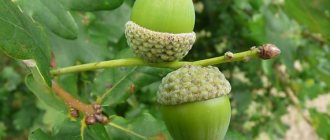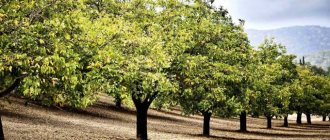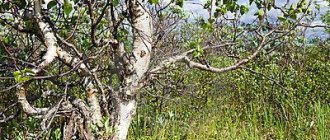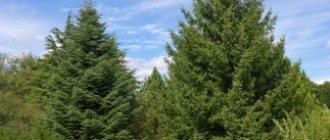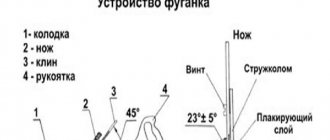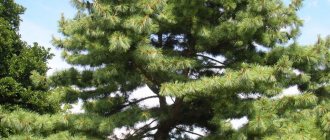Hazel or hazel (Corylus) is a representative of the Birch family. This genus is represented by deciduous trees and shrubs. It unites approximately 20 species. They are found naturally in North America and Eurasia. At the same time, in coniferous-deciduous forests they form undergrowth. The most popular type among gardeners is hazelnut or common hazel. The following cultivated species are often called hazelnuts: large hazel, Pontic hazel and common hazel. The hollow is one of the oldest cultivated plants in Europe. For many centuries, hazel has been cultivated in Spain, France, Great Britain, Turkey, Italy and Germany. Hazel fruits appeared on the territory of Russia in 1773 in the process of exchange for velvet and leather. The word hazel comes from “leska”, which means hazelnut.
Features of hazel
Hazel is represented by shrubs and trees. The height of the plant can reach up to 7 meters. Its crown shape is ovoid or spherical, with a cone-shaped top. Large leaf plates of round or wide oval shape have a jagged edge. The flowers are monoecious as well as unisexual. Thus, male flowers begin to form in autumn and form fluffy cylindrical earrings on short branches. They open in the spring even before the leaf plates appear. Hazel blooms in the last days of March or the first days of April. During it, a lot of pollen is formed; it is considered the main food for bees after a long winter. During flowering, the plant is decorated with golden earrings and flowers. The fruit is a not very large (approximately 20 mm in diameter) single-seeded nut of brown-yellow color and spherical shape. It is surrounded by a plus (tubular incised cover), as well as a woody pericarp. Fruit ripening is observed in August.
This culture prefers to grow in regions with subtropical and temperate climates. Hazel plantations are located in the southern part of Europe, Turkey, Azerbaijan, Ukraine, Cyprus, Georgia, Belarus, and also central Russia. However, in private gardens this crop is much less common than sea buckthorn, hawthorn, bird cherry, rose hip, actinidia, etc.
Hazel. Forest Hazelnut, Leshina "Contorta". Unpretentious Garden Shrubs
Hazel: is it a shrub or a tree?
Hazel unites the genus of shrubs, but among more than 20 species of its representatives there are also trees. For example, the bear nut, which will be discussed further, is a magnificent specimen of a tree, slender and tall, with a beautiful crown shape. But most hazel species are still shrubs, the wild forms of which form dense undergrowth in deciduous forests. The most widespread and of high economic importance is hazel, or common hazel. The history of the origin of the word “hazel” is interesting. This original Russian name comes from the noted similarity of the outlines of the leaves of the bush with the body shape of the lake fish bream, known since ancient times as the breadwinner of the Russians.
Planting hazel in the garden
What time to plant
Hazel can be planted in open ground in the spring, before sap flow begins, and also in the fall - 15–20 days before the onset of persistent frosts. However, it should be noted that it is better to plant in the autumn.
When searching for a suitable area for planting, please note that it must be protected from drafts and be moderately lit. As for groundwater, it should lie no higher than 150 cm from the surface of the site. A location located in close proximity to the southern or western wall of the building is ideal. Those places where there is an accumulation of melt water in the spring are not suitable for planting. You also need to take into account that the distance between the nearest large tree and the seedling should be from 4 to 5 meters, since the optimal feeding area for this plant is 16–25 m2. It must be remembered that the soil on the site should not be heavy, poor, loamy or swampy. Loose and light soil rich in humus is best suited for planting this crop, but it should be slightly acidic or neutral.
If you plan to plant several hazels at once, it is recommended to deeply dig up the entire area before this procedure.
Planting hazel in autumn
The selected seedling should not have foliage. It should have 3 or 4 powerful stems, reaching at least 10–15 mm in diameter. At the same time, its root system should be very well developed. The roots should reach at least half a meter in length, but immediately before planting they are shortened to 0.25 m. When planting several specimens, the distance between them in a row should be from 4 to 5 meters, with a row spacing of about 6 meters. The preparation of pits for planting should be started 4 weeks before the planting day, during which time the soil in them will be compacted and settle well. If the soil on the site is saturated with nutrients, then the width and depth of the pit should be only 0.5 m. If it is poor, then the width and depth of the pit should be increased to 0.8 m. Before planting, the pit should be filled with nutrients soil mixture: soil from the top fertile layer must be combined with 2 tbsp. wood ash or 200 grams of superphosphate and 15 kilograms of rotted manure. It will be very good if you add a few handfuls of soil taken from under the hazel tree.
In the middle of the pit, a mound should be formed on which the seedling is installed. Before planting hazel, do not forget to lower its root system into a clay and manure mash. It should be noted that after planting, the root collar of the plant should rise 50 mm above the surface of the site. The pit must be filled, after which the surface of the tree trunk is well compacted. You need to install a stake near the seedling and tie it up. The planted plant needs abundant watering, and 30–40 liters of water are poured under 1 bush, even if the planting was done in moist soil. After the liquid is completely absorbed into the soil, the surface of the tree trunk circle should be covered with a layer of mulch (humus, sawdust or peat), and its thickness should be 30–50 mm.
Planting hazel (hazel)
How to plant a hazel tree in spring
In the spring, the hollow is planted in the same way as in the fall. However, in this case, it is recommended to prepare the pit for planting in the autumn, so that during the winter the soil can be well compacted and saturated with moisture.
In order for the hazel to be accurately pollinated, experts advise planting at least 3 specimens on the site, and it is better if they are all different varieties. Also, do not forget to pour a few handfuls of soil from under the hazel into the pit when planting the plant, since it contains fungi that are very favorable for this crop. At first, it is recommended to protect the seedlings from the direct rays of the spring sun by shading them.
Hornbeam
The Birch family also includes hornbeam. China and Asia are considered its homeland. It thrives in both shade and sun, but prefers moist soil, so in dry summers it needs additional watering.
In terms of life expectancy, the hornbeam does not fit into the Birch family, the characteristics of which are generally the same, and the average reaches 100-120 years. The same tree easily lives up to 300 years, growing up to 30 m in height and up to 8 m in width.
The hornbeam blooms with small male and female inflorescences in the form of earrings, but begins to bear fruit only after 15-20 years. The wood of this tree is used to make furniture and kitchen utensils, but only after special treatment to prevent rotting, since it absorbs moisture and quickly deteriorates.
Hazel care
There is nothing difficult about growing hazel. And to simplify your task as much as possible, it is recommended to sow lupine, mustard or oats with vetch in the tree trunk circle. When such grass is mowed, it will create an excellent mulch layer. Also, if desired, the soil in the tree trunk circle can be kept under black fallow; in this case, it must be periodically loosened to a depth of 40 to 70 mm, removing all weeds. In addition, it will be necessary to systematically remove the root shoots, and it should be taken into account that it is much easier to get rid of the shoots while they are still quite weak. To do this, the shoot should be dug up and cut off where it grows from the root of the tree. The cut areas should be sprinkled with crushed charcoal.
How to water
Holly grown in the garden needs timely watering. Seedlings planted in open ground should begin to be watered just 7 days after this. If the plant lacks water, this will have an extremely negative impact on the formation of flower buds, as well as on the ripening of fruits. During the growing season, the plant will need 5 or 6 waterings, and 60–80 liters of water should be poured under an adult tree at a time. If there is drought in the summer, the amount of watering should be increased, since this plant is moisture-loving. But if the summer turns out to be rainy, then you won’t have to water the hazel tree at all. On average, watering is done once every 4 weeks. You should pour water under the tree in parts, because it should have time to be absorbed, and not stand in a puddle for hours. It is recommended to loosen the soil surface around the plant the next time after watering or rain.
Fertilizer
Hazel growing in the garden needs timely feeding. In autumn, the tree needs phosphorus and potassium; for this, 20 to 30 grams of potassium salt, 3–4 kilograms of manure and 50 grams of superphosphate should be added to the tree trunk once every 2 or 3 years. In spring, such a crop needs nitrogen, so after the buds swell, 20 to 30 grams of urea or ammonium nitrate should be added to the soil under the tree. The hollow also needs nitrogen in July, at which time it is needed so that fruit ripening occurs simultaneously. It is recommended to feed young trees with organic fertilizers (rotted manure or compost). This fertilizing should be carried out once every 2 or 3 years, and 10 kilograms of organic matter should be added per tree.
How to care during flowering
If the plant develops normally, it will definitely bloom. Flowering begins in April, with flowers blooming before the foliage opens. After the air outside warms up to 12 degrees, hazel catkins begin to actively grow, with their length increasing by 30 mm every 24 hours. It should also be noted that the drier the air, the faster the catkins will grow. After their length is 10 centimeters, they become loose and pollen begins to be scattered. The duration of this dusting is 4–12 days. Female flowers remain open for 14 days. Pollen from male flowers falls on female flowers, and it can come not only from its own tree, but also from a nearby tree. This is precisely why the recommendation is that at least 3 hazel trees should grow on the site.
Hazel propagation
There are several ways to propagate the hollow: layering, grafting, dividing the bush, seeds, suckers and cuttings. The generative propagation method is mainly used by breeders to obtain new varieties that will be adapted to certain climatic conditions. But amateur gardeners, as a rule, do not grow hazel from seeds, because it takes a very long time, and only 1 seedling out of 1 thousand grown can retain the varietal characteristics of the parent plant.
Reproduction by taps
Using generative methods of propagation, it is possible to completely preserve the varietal characteristics of a plant. To propagate hazel, horizontal layering is used. To do this, at the beginning of spring or in late autumn, you need to select annual branches that should be low-growing. Shallow grooves are made under them (depth from 10 to 15 centimeters) into which these branches are placed. They need to be fixed and the upper part remaining above the ground slightly shortened. Do not fill furrows with soil. Over time, vertical shoots will grow from the buds located on the branches. All leaf plates must be removed from the lower part of the grown shoots, and they will also require several hillings to the middle. Over time, the shoots will form their own roots and can be transplanted to a new location. Such seedlings can be transplanted to a permanent place only after 1 or 2 years, since they need to be grown.
Using the same principle, hazel can be propagated by arc layering. In spring, the selected branches should be bent in an arched manner to the soil. In the place where the branch comes into contact with the ground, the bark must be cut. Then the branch is fixed in a hole, the depth of which should be from 0.2 to 0.3 m, after which it is filled with soil so that the upper part rises above the surface of the site, while it needs to be tied to a peg installed nearby. The cuttings that have given root must be cut off from the parent tree in the autumn, after which it is dug up and planted in another place for growing. It can be transplanted to a permanent place after 1 or 2 years.
You can also propagate the hollow quite easily by vertical layering. When rejuvenating pruning is carried out in the spring, you need to find the stumps of fairly large branches and hermetically wrap them with film at a height of 0.5 m. This helps awaken the dormant buds and they begin to grow. After the height of the regrown young shoots is 15 centimeters, they should be hilled with humus to a height of 40–50 mm. But before that, do not forget to bandage them at the very bottom, and use soft wire for this. After the length of the shoots reaches 0.2–0.25 m, they are hilled with humus to a height of 8 to 12 centimeters. And after their length becomes 0.3–0.35 m, they are hilled to a height of 0.2 m, and the surface around them is covered with a layer of mulch. When the shoots are hilled for the third time, you need to remove the film. During the summer period, the bush must be provided with regular watering and weeding. Don’t forget, before you start hilling, tear off all the lower leaf plates from the shoot each time. In autumn, you need to dig out the shoot very carefully, while trying not to injure the adventitious roots. Those cuttings that have given roots should be broken off at the point of constriction. Those shoots that have produced a small number of roots should not be separated.
Hazelnut propagation by layering
Reproduction by offspring
Hazel shoots grow 100 cm in diameter from the trunk. The first offspring appear 1 or 2 years after planting the seedling; they grow from dormant buds located on the root system, and they appear from the soil at a distance from the parent bush. Hazel can be propagated by peelings - these are two- or three-year-old offspring that grow on the periphery. You need to remove such a shoot from the rhizome using an ax, after which it is transplanted into a school for growing. If desired, they can be planted in a permanent place, but in this case 2 or 3 peels should be placed in one planting hole.
Reproduction by grafting
Hazel can also be propagated by grafting. A wild hazel seedling can be used as a rootstock. However, experts recommend taking a bear nut seedling as a rootstock, which does not produce root shoots. Grafting is carried out in the summer using the budding method with a germinating eye or in the spring using the cutting method in the butt, behind the bark or in a split. As a scion, you should use cuttings taken from the middle part of the stem; you can also take the apical ones. Cuttings are harvested in winter. They should be preserved until spring by placing them in a snowdrift or in the refrigerator.
Reproduction by dividing the bush
Propagation of the hollow by dividing the bush is also a fairly simple procedure. The bush removed from the ground should be divided into several parts, and each section should have roots reaching 15–20 centimeters in length. The cut areas must be sprinkled with crushed coal, and then the separated parts are planted in holes, which must be prepared in advance.
Birch Fastigiata
This variety of warty birch differs from it in the structure of its crown. It is narrow and wedge-shaped, and the branches stretch upward, unlike its drooping “relative”. With a small height of only 10 m, Fastigiata (Birch family) has a very powerful root system and a wind-resistant trunk.
This tree grows very quickly - up to 40 cm per year, and its life expectancy rarely exceeds 100 years. The foliage is the same as that of warty birch, but lasts much longer, until late autumn. It blooms with small green, irregularly shaped flowers up to 1 cm long.
This tree tolerates both dry summers and cold winters equally well. Natural pests are chafer beetle, chimney beetle (beetle), Bucephalus corydalis, birch sapwood and nun moth.
Hazel trimming
Hazel can be trimmed in winter. But it is best to do this in spring, at the late stage of flowering. The fact is that during flowering the plant will shake during the pruning process, which will have an extremely beneficial effect on the efficiency of pollination.
Pruning rules
Hazel can be cultivated as a tree on a trunk, the height of which can vary from 0.35 to 0.4 m. However, a hazel tree shaped like a bush is easier and more convenient to care for. 7 days after planting the seedling in the garden, it should be shortened to 0.25–0.3 m. During the summer period, shoots will grow on the bush, which should not be removed; it must be remembered that hazelnut fruiting is observed on one-year-old wood. With the onset of spring, you need to start shaping the bush. All shoots except the 10 most powerful ones must be removed. The remaining shoots should grow from the center of the bush in different directions at a distance from each other.
All injured, competing, diseased, weak and deformed stems should be pruned. Make sure that the bush does not thicken. In the fourth year after planting the seedling in the soil, it will begin to bear fruit. At this time, it is imperative to carry out both thinning and sanitary pruning of the bush in a timely manner. When the age of the tree reaches 18–20 years, its yield begins to fall; to prevent this, they resort to rejuvenating pruning. Every year, 2 or 3 old trunks must be cut out into a stump, and they must be replaced with the same number of basal shoots, which should grow fairly close to the center of the bush. Young skeletal branches need to be shortened slightly, as this helps stimulate the growth of lateral shoots on them.
If you grow a hollow in the form of a tree, then 7 days after planting the seedling in open ground, all its stems should be removed, only the trunk should remain. As soon as new stems appear, you will need to trim those that are located at the bottom of the trunk. And in its upper part it is necessary to form 4 or 5 skeletal branches. Remember that it is very important to cut out all root shoots in a timely manner.
Hazelnut pruning 02/21/2022 Batkiv Garden
What does hazel look like?
The vast majority of hazel species are deciduous shrubs with large, rounded leaves of a magnificent rich green color. Hazel gravitates toward the warm, moist, fertile soils of broad-leaved forests and gets along well with their permanent residents: oaks, elms, maples, dominating the undergrowth and often forming a solid wall. Wild hazel species are branched shrubs with a large number of stems coming from the rhizome. They reach a height of 3-5 meters. Bushes can reproduce vegetatively (offshoots and cuttings) or by seeds - nuts. They begin to bear fruit in the 6-7th year with seed propagation, and in the 4th year with vegetative reproduction. In summer, a hazel bush can be easily identified by its leaves, which have an oval shape and are decorated along the edges with small teeth and a sharp tip. The hazel leaf has a slightly rough texture to the touch.
Basically, the hazel crop is a shrub 5–6 meters in height with smooth bark, the color of which varies from grayish to terracotta-brown. Young shoots are usually colored gray-green, interspersed with small yellowish specks. Young shoots are similar in appearance to linden shoots, differing only in their rather dense pubescence. Hazel shoots can easily be confused with elm. Both their leaves and bark are very similar in color and texture. But there are also differences. The elm, like a real tree, always has only one trunk, and the young growth of hazel is multiple, which is typical of a shrub. In addition, hazel has oval gray-green buds, while elm has reddish and pointed buds.
Pests and diseases of hazel with photos
Hazel pests
Hazel can be harmed by insects such as leaf beetles, aphids, nut weevils, longhorned beetles, and also bud mites.
Kidney mite
The kidney mite is a small insect, reaching 0.3 millimeters in length. For the winter it hides in hazel buds, and in the spring it lays eggs in them. Those buds where the mite lives can be easily distinguished from healthy ones. So, they swell greatly and become similar in size to a large pea. Then, when healthy buds open, those that have become a “house” for pests dry out and fall off.
Aphid
Aphids are very small sucking insects that suck cellular sap from trees. It should also be remembered that this pest is the main carrier of viral diseases. It is quite difficult to notice aphids on hazel, which is where the main danger lies. Because of this pest, the foliage becomes twisted, the buds and stems are deformed, they begin to develop relatively slowly, and the fruits do not fully ripen.
Nut weevil
The nut weevil is a brown beetle that reaches 10 mm in length. The caterpillar of such a pest has a milky yellow body and a brown-red head. Its female lays her eggs in unripe fruits, and her larvae eat the pulp of the nut. If the tree is very badly affected, it is possible that up to half of all fruits will be spoiled.
Walnut (hazelnut) barbel
The hazelnut (walnut) longhorned beetle is an extremely dangerous harmful insect, which is a black bug, reaching 1.5 cm in length, with yellow legs. The larvae gnaw out the core of the stems, after which they begin to dry out, while the upper leaf blades turn yellow and curl.
Walnut leaf beetle
The walnut leaf beetle is a beetle reaching 0.6–0.7 cm in length; its elytra are purple in color. This leaf-eating pest is the most dangerous. The larvae of this insect are painted dark green, so they are almost impossible to see against the background of foliage, on which they live and develop for quite a long time. This insect harms alder, hazel and willow.
hazelnut / PROBLEMS / solve…
Hazel diseases
Hazel has a relatively high resistance to disease, and it only suffers from branch rot, rust and powdery mildew.
Powdery mildew
Powdery mildew is a fairly common disease that any gardener is familiar with. The affected plant develops a whitish coating on the surface of the stems and foliage; after some time it thickens and changes its color to brown. Infected parts of the plant stop growing, they become dark and die. Ovaries do not form on the inflorescences, and the frost resistance of the tree is greatly reduced.
Rust
Rust is a fungal disease. In the affected plant, dark red tubercles appear on the front surface of the foliage, while oval or round pustules form on the back surface. Over time, the spots become stripes, and the leaves turn yellow and fly away.
White rot
White rot can affect a plant in various ways, namely: as peripheral rot or as mixed rot of branches. In both the first and second cases, severe damage can be caused to the plant, which in some cases causes it to die.
Hazel processing
If you find pests on the bush, it is recommended to cover the soil under it with polyethylene, after which the plant should be shaken until all the insects fall from it onto the film. When there are a lot of pests on the bush, it should be sprayed with a solution of an insecticidal preparation, and it should be remembered that sucking insects are gotten rid of with the help of an acaricide. The best results are shown by such products as: Actellik, Karbofos, Chlorophos and others of similar action.
If hazel is severely affected by a fungal disease, it must be treated with fungicidal preparations, for example: copper sulfate, Bordeaux mixture and others made on the basis of copper. In order to prevent fungal diseases, it is recommended to follow the agrotechnical rules of this crop and also properly care for the plant.
Alder
Although alder is included in the Birch category, the family cannot boast of a more extraordinary tree than this. It is unique in everything:
- Firstly, it first blooms and then opens its leaves.
- Secondly, alder “opens” spring. Its flowering begins when there is still snow on the ground, and warmth is only anticipated in the air.
- Thirdly, its leaves do not turn yellow, but remain green in late autumn.
- Fourthly, alder foliage is so filled with nitrogen that it itself fertilizes the soil on which the tree grows.
- Fifthly, the unique property of its wood becoming harder under the influence of moisture makes it indispensable in the construction of wells and the manufacture of barrels.
Although there are up to 50 species of this tree, the two most common are black and gray alder. It got its name black (sticky is the second name) due to its trunk, which darkens as it matures. It is called sticky because of its leaves. Most often it grows alone or in a group of similar trees. Black alder begins to bloom in April, and the fruits fully ripen only after a year. Loves light and moisture.
Gray alder has not only a trunk of this color, but also leaves. It is unpretentious, frost-resistant and grows even on poor soil. Since gray alder tends to quickly grow into impenetrable thickets, it is most often planted to secure the banks and slopes of hollows and ravines.
Types and varieties of hazel with photos and names
It was already mentioned above that there are approximately 20 types of hazel. At the same time, cultivated species have a large number of varieties, varieties and hybrids. Below we will describe those that are most popular among gardeners.
Common hazel (lat. Corylus avellana)
The height of this multi-stemmed shrub is 4–6 m. The crown is spreading and wide, reaching 4 meters in diameter. There is pubescence on the surface of the stems. round leaf plates reach 9 centimeters in width and 12 centimeters in length. This plant blooms before the leaves open. The spherical nuts, up to 15 mm in diameter, are covered with a brownish peel. Their ripening is observed in September. This species can be found both in natural conditions and in culture.
Tree hazel (lat. Corylus colurna), or bear nut
The fruits of this decorative species are very tasty. It is considered the only one of all species that is represented by trees. Its height is about 8 m, but in regions with a warm climate such a tree can grow up to 20 m. The lifespan of this plant is approximately 200 years. Broadly ovate leaf plates are placed on petioles reaching a length of 50 mm. The fruits of this plant are larger in size compared to other species, but their kernels are smaller, but much tastier compared to hazelnut kernels.
Manchurian hazel (lat. Corylus mandshurica)
The height of such a multi-stemmed, highly branching shrub is about 5 meters. The bark is fissured, dark gray in color. A characteristic feature of this species is the fruits and foliage of an oblong shape. The fruits have a prickly coating, making them relatively difficult to peel. This species is found naturally in the Far East and China.
Variegated hazel (lat. Corylus heterophylla)
The height of the bush is about 300 cm. Its top is truncated, and the foliage is bilobed. In spring, catkins of male inflorescences grow on it, and inconspicuous buds of female flowers, painted red, are also formed. The formation of fruits is observed in a leaf wrapper of 2 or 3 pieces. In nature, this shrub can be found in China, the Far East, Japan and Korea. The species is distinguished by its unpretentiousness to climatic conditions, and it grows well in mid-latitudes.
Red-leaved hazel (Corylus atropurpurea)
The height of this ornamental shrub varies from 4 to 6 meters. The crown is very dense. The leaves have a dark purple color, which changes to green closer to autumn. The buds and earrings are dark burgundy. Thanks to this species, a large number of hybrids have appeared, as well as varieties that are very popular among gardeners.
Large hazel (lat. Corylus maxima), or Lombard nut
The height of the bush is about 10 meters. The nuts are placed in a tubular wrapper, and it is a couple of times larger than the fruits themselves. The fleshy kernels have an elongated shape. Under natural conditions, such hazel grows in Italy, Turkey and Asian countries.
There are also such species as: Chinese, American, Colchian, horned, Himalayan, or fearsome hazel, Siebold, etc.
In mid-latitudes the following varieties of hazel are most popular:
- Isaevsky . This variety is one of the most valuable. It has good winter hardiness and large fruits with high taste.
- Masha . This is a hybrid of red-leaved hazel. It is characterized by frost resistance and productivity. The medium-sized elongated nuts are very tasty; they are covered with a thin shell.
- Roman . This mid-season Italian variety is resistant to pests and diseases. Very beautiful large flat-round fruits have a wonderful taste.
Even in the middle latitudes, varieties such as Ekaterina, Moscow Rubin, Pamyat Yablokova, Pervenets, Pushkinsky Red, Ivanteevsky Red, Kudraif, Moscow Early, Purpurny, Sakharisty, Sakharny, a series of varieties Severny, Tambovsky Early, Tambovsky Late, Lentina, are popular. Alida, Lena, etc.
And in Ukraine and in the southern regions of Russia, varieties such as Panakhessky, Altai, Cherkessky, Kuban, Perestroika, Futkurami, etc. are popular.
HAZELNUT VARIETIES
Looking for the difference
First, it’s worth understanding what a hazelnut, or hazel, is. This is a shrub or tree that grows in different countries and climate zones. There are 22 types of hazelnuts in total. They differ in height, resistance to heat and cold, lifespan, yield and other indicators. Some of these varieties have been crossed by experienced breeders to improve the breed. And as a result, hazelnuts were bred.
Therefore, we can say with confidence that hazelnuts are simply one of the varieties of hazel, an improved variety. But it’s still worth figuring out - if we consider hazelnuts and hazelnuts, what is the difference between them.
Primarily in the size of the fruit. In wild nuts they are much smaller than in cultivated ones. In addition, if well cared for, hazelnuts produce a rich harvest every year. And for a wild nut, even if you plant it in the garden and carefully care for it, the yield is much lower. On the other hand, if you want to grow it at your dacha, where you won’t be able to come at least once a week to take care of the garden, then it makes sense to choose hazel, as it is more durable and less demanding of growing conditions.
Again, if you understand the difference between hazelnuts and hazelnuts, then it is not difficult to identify the dependence before the weather. Hazel grown in the forest easily tolerates spring frosts and low temperatures in winter. But hazelnuts may well freeze - you need to take proper care of them in order to get a rich harvest and not lose the bush into which so much effort and labor has been invested.
Now that we have figured out how hazelnuts differ from hazelnuts, it’s worth learning more about them.
Properties of hazel: harm and benefit
Useful properties of hazel
Hazelnuts contain many beneficial substances that are necessary for the human body. Thus, the kernel contains vitamins A, PP, C and E and B vitamins, as well as amino acids, fatty oils, iron, iodine, calcium, magnesium, copper, fluorine, manganese and potassium. In terms of their biological indicators, nuts are equivalent to proteins; therefore, experts advise eating them separately from other foods.
Benefits of hazelnuts:
- has a positive effect on attention and memory;
- normalizes the functioning of the cardiovascular system;
- helps strengthen the immune system and accelerate metabolic processes;
- has a positive effect on the body when it is depleted, and is also used for recovery after a serious illness;
- It is recommended to use it for anemia, allergies, obesity, rheumatism, urolithiasis, burns, measles, anemia, epilepsy, and also to enhance hair growth and cleanse the liver.
An infusion of hazel leaves is indicated for varicose veins, prostate hypertrophy, thrombophlebitis and trophic ulcers. An infusion of the bark is used for diabetic retinopathy; it can also improve blood circulation in small vessels. This infusion also has a vasoconstrictor effect. It is recommended to wash your hair with a decoction of plusa and bark so that it becomes darker in color. A decoction of the leaves can eliminate swelling of the eyelids and redness of the skin.
HAZELNUT BENEFITS AND HARM | hazelnut benefits, hazelnut hazelnuts beneficial properties, what are the benefits of hazelnuts

